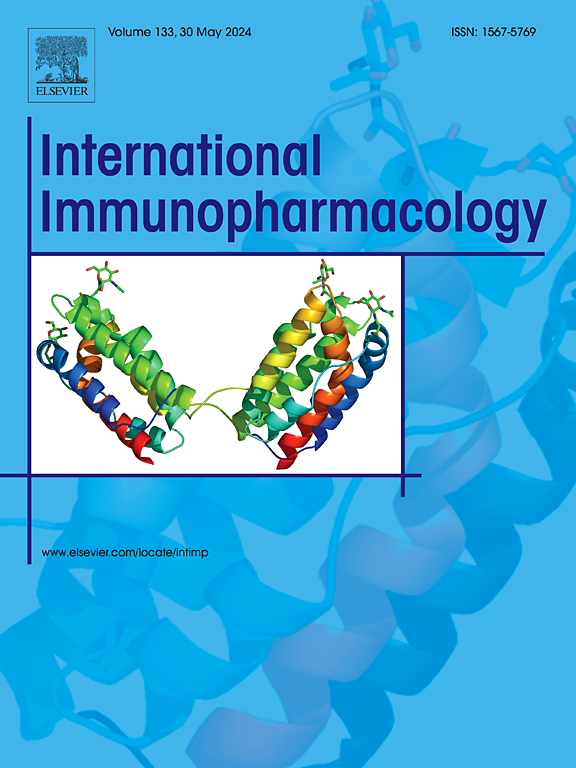Mesenchymal stromal cells reduce ferroptosis of podocytes by activating the Nrf2/HO-1/GPX4 pathway in lupus nephritis
IF 4.8
2区 医学
Q2 IMMUNOLOGY
引用次数: 0
Abstract
Background
Ferroptosis has been reported to be involved in the occurrence and development of various kidney diseases. Emerging evidence suggests that ferroptosis also plays a critical role in systemic lupus erythematosus (SLE) and lupus nephritis (LN), contributing to podocyte injury and renal dysfunction. Mesenchymal stromal cells (MSCs) have become an attractive option for podocyte injury repairing in LN. The aim of this research was to determine whether MSCs regulate ferroptosis of podocytes in LN.
Methods
MSCs were injected into female MRL/lpr mice via tail vein. The symptoms of LN and the detection of ferroptosis-related biomarkers in podocytes were detected. In vitro validation was conducted by mouse podocyte cell line MPC-5.
Results
The occurrence of ferroptosis and involvement of Nrf2/heme oxygenase-1 (HO-1) signaling pathway in podocytes were observed. We found increased expression of the podocyte marker, Wilm's tumor 1 (WT-1) and synaptopodin, following the improvement of lupus-like symptoms after MSC transplantation in MRL/lpr mice. The expression of ferroptosis-related protein glutathione peroxidase 4 (GPX4) and long chain acyl-CoA synthetase 4 (ACSL4) were elevated in renal, along with the Nrf2 and HO-1 activity enhancement. In vitro, MSC treatment maintain a stabilization of podocyte actin stress fibers, leading to an improvement of cell viability. Furthermore, our results showed that puromycin aminonucleoside (PAN) induce accumulation of cellular lipid reactive oxygen species (ROS) and glutathione depletion, and the expression of Nrf2, HO-1 and GPX4 were all downregulated whereas the expression of ACSL4 was upregulated. However, these effects were reversed by MSCs and ferroptosis inhibitor ferrastatin-1 (Fer-1). The promotion of Nrf2 nuclear translocation was observed after the treatment with MSCs.
Conclusion
Ferroptosis activation is involved in the development of LN. MSCs could ameliorate podocyte injury in LN by inhibiting ferroptosis through the Nrf2/HO-1/GPX4 pathway, which will provide novel potential therapeutic targets for LN.
求助全文
约1分钟内获得全文
求助全文
来源期刊
CiteScore
8.40
自引率
3.60%
发文量
935
审稿时长
53 days
期刊介绍:
International Immunopharmacology is the primary vehicle for the publication of original research papers pertinent to the overlapping areas of immunology, pharmacology, cytokine biology, immunotherapy, immunopathology and immunotoxicology. Review articles that encompass these subjects are also welcome.
The subject material appropriate for submission includes:
• Clinical studies employing immunotherapy of any type including the use of: bacterial and chemical agents; thymic hormones, interferon, lymphokines, etc., in transplantation and diseases such as cancer, immunodeficiency, chronic infection and allergic, inflammatory or autoimmune disorders.
• Studies on the mechanisms of action of these agents for specific parameters of immune competence as well as the overall clinical state.
• Pre-clinical animal studies and in vitro studies on mechanisms of action with immunopotentiators, immunomodulators, immunoadjuvants and other pharmacological agents active on cells participating in immune or allergic responses.
• Pharmacological compounds, microbial products and toxicological agents that affect the lymphoid system, and their mechanisms of action.
• Agents that activate genes or modify transcription and translation within the immune response.
• Substances activated, generated, or released through immunologic or related pathways that are pharmacologically active.
• Production, function and regulation of cytokines and their receptors.
• Classical pharmacological studies on the effects of chemokines and bioactive factors released during immunological reactions.

 求助内容:
求助内容: 应助结果提醒方式:
应助结果提醒方式:


